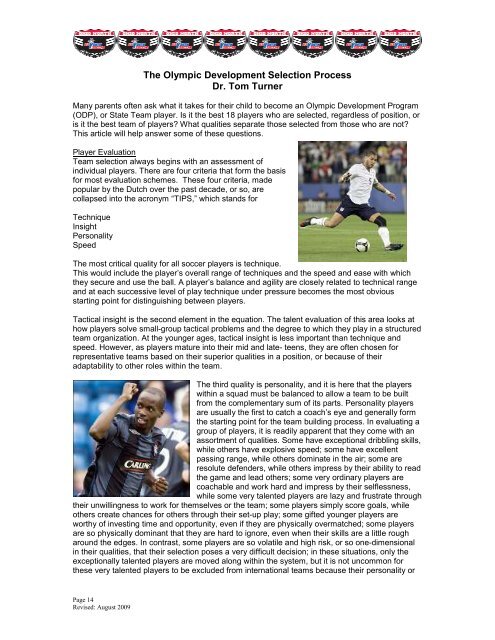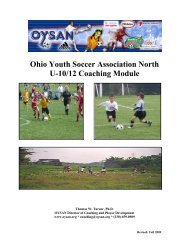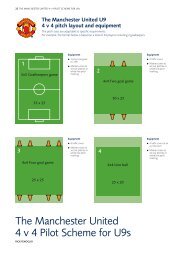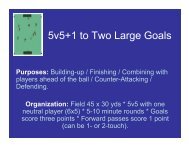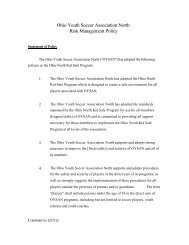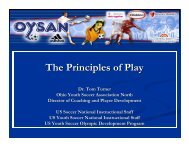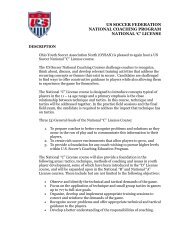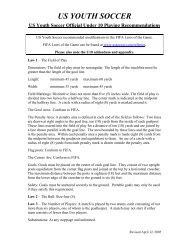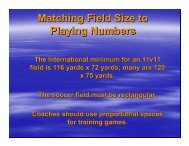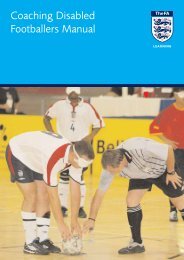What is the US Youth Soccer Olympic Development Program?
What is the US Youth Soccer Olympic Development Program?
What is the US Youth Soccer Olympic Development Program?
You also want an ePaper? Increase the reach of your titles
YUMPU automatically turns print PDFs into web optimized ePapers that Google loves.
The <strong>Olympic</strong> <strong>Development</strong> Selection Process<br />
Dr. Tom Turner<br />
Many parents often ask what it takes for <strong>the</strong>ir child to become an <strong>Olympic</strong> <strong>Development</strong> <strong>Program</strong><br />
(ODP), or State Team player. Is it <strong>the</strong> best 18 players who are selected, regardless of position, or<br />
<strong>is</strong> it <strong>the</strong> best team of players <strong>What</strong> qualities separate those selected from those who are not<br />
Th<strong>is</strong> article will help answer some of <strong>the</strong>se questions.<br />
Player Evaluation<br />
Team selection always begins with an assessment of<br />
individual players. There are four criteria that form <strong>the</strong> bas<strong>is</strong><br />
for most evaluation schemes. These four criteria, made<br />
popular by <strong>the</strong> Dutch over <strong>the</strong> past decade, or so, are<br />
collapsed into <strong>the</strong> acronym “TIPS,” which stands for<br />
Technique<br />
Insight<br />
Personality<br />
Speed<br />
The most critical quality for all soccer players <strong>is</strong> technique.<br />
Th<strong>is</strong> would include <strong>the</strong> player’s overall range of techniques and <strong>the</strong> speed and ease with which<br />
<strong>the</strong>y secure and use <strong>the</strong> ball. A player’s balance and agility are closely related to technical range<br />
and at each successive level of play technique under pressure becomes <strong>the</strong> most obvious<br />
starting point for d<strong>is</strong>tingu<strong>is</strong>hing between players.<br />
Tactical insight <strong>is</strong> <strong>the</strong> second element in <strong>the</strong> equation. The talent evaluation of th<strong>is</strong> area looks at<br />
how players solve small-group tactical problems and <strong>the</strong> degree to which <strong>the</strong>y play in a structured<br />
team organization. At <strong>the</strong> younger ages, tactical insight <strong>is</strong> less important than technique and<br />
speed. However, as players mature into <strong>the</strong>ir mid and late- teens, <strong>the</strong>y are often chosen for<br />
representative teams based on <strong>the</strong>ir superior qualities in a position, or because of <strong>the</strong>ir<br />
adaptability to o<strong>the</strong>r roles within <strong>the</strong> team.<br />
The third quality <strong>is</strong> personality, and it <strong>is</strong> here that <strong>the</strong> players<br />
within a squad must be balanced to allow a team to be built<br />
from <strong>the</strong> complementary sum of its parts. Personality players<br />
are usually <strong>the</strong> first to catch a coach’s eye and generally form<br />
<strong>the</strong> starting point for <strong>the</strong> team building process. In evaluating a<br />
group of players, it <strong>is</strong> readily apparent that <strong>the</strong>y come with an<br />
assortment of qualities. Some have exceptional dribbling skills,<br />
while o<strong>the</strong>rs have explosive speed; some have excellent<br />
passing range, while o<strong>the</strong>rs dominate in <strong>the</strong> air; some are<br />
resolute defenders, while o<strong>the</strong>rs impress by <strong>the</strong>ir ability to read<br />
<strong>the</strong> game and lead o<strong>the</strong>rs; some very ordinary players are<br />
coachable and work hard and impress by <strong>the</strong>ir selflessness,<br />
while some very talented players are lazy and frustrate through<br />
<strong>the</strong>ir unwillingness to work for <strong>the</strong>mselves or <strong>the</strong> team; some players simply score goals, while<br />
o<strong>the</strong>rs create chances for o<strong>the</strong>rs through <strong>the</strong>ir set-up play; some gifted younger players are<br />
worthy of investing time and opportunity, even if <strong>the</strong>y are physically overmatched; some players<br />
are so physically dominant that <strong>the</strong>y are hard to ignore, even when <strong>the</strong>ir skills are a little rough<br />
around <strong>the</strong> edges. In contrast, some players are so volatile and high r<strong>is</strong>k, or so one-dimensional<br />
in <strong>the</strong>ir qualities, that <strong>the</strong>ir selection poses a very difficult dec<strong>is</strong>ion; in <strong>the</strong>se situations, only <strong>the</strong><br />
exceptionally talented players are moved along within <strong>the</strong> system, but it <strong>is</strong> not uncommon for<br />
<strong>the</strong>se very talented players to be excluded from international teams because <strong>the</strong>ir personality or<br />
Page 14<br />
Rev<strong>is</strong>ed: August 2009


